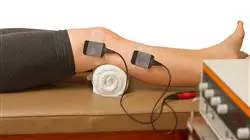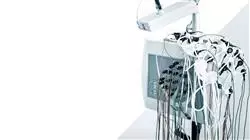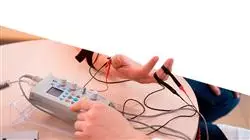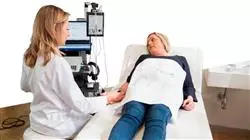University certificate
The world's largest faculty of medicine”
Description
Treat ailments such as fibromyalgia or chronic pain with the latest neurophysiological techniques, becoming the best practitioner in your area"

The management of pathologies such as drug-resistant chronic pain, epilepsy, fibromyalgia or even depression can benefit from the appropriate use of neurophysiological therapies. Throughout this course, the student will learn about the latest advances in this field and how to apply the different types of neuromodulation techniques to different ailments.
Thus, students will gain extensive knowledge of neurophysiological therapies, a speciality that will undoubtedly be of great use in their medical career, as it will allow them to treat various common pathologies more effectively.
An awareness of the continuous advances made in neurophysiological therapies will also provide the student with significant scope for growth within their area of healthcare.
All this in a completely online postgraduate certificate, where the student can download the entire syllabus from the first day of teaching. This, together with the absence of classes and fixed schedules, makes it possible for the student to decide when to assume the entire study load, without abandoning their current work or personal commitments.
You are choosing the best academic institution, with professional and personalized support that you won't find in other programs"
This postgraduate certificate in Neurophysiological Techniques for Therapeutic Purposes. Invasive and Non-Invasive Neuromodulation. Botulinum Toxin contains the most complete and up-to-date scientific program on the market. Its most notable features are:
- Practical case studies presented by experts in Neurophysiology
- Graphic, schematic, and practical contents which provide scientific and practical information on the disciplines that are essential for professional practice
- Practical exercises where self-assessment can be undertaken to improve learning
- A special emphasis on innovative methodologies
- Theoretical lessons, questions to the expert, debate forums on controversial topics, and individual reflection assignments
- Content that is accessible from any fixed or portable device with an Internet connection
Don't waste your time and money on other titles that don’t take you into consideration. At TECH you make all the important decisions, without sacrificing any aspect of your personal and work life"
The program’s teaching staff includes professionals from the sector who pour their professional experience into this program, as well as renowned specialists from leading societies and prestigious universities.
The multimedia content, developed with the latest educational technology, will provide the professional with situated and contextual learning, i.e., a simulated environment that will provide immersive learning designed for real situations.
This program is designed around Problem-Based Learning, whereby the professional must try to resolve the different professional practice situations that arise during the academic year. For this purpose, the student will be assisted by an innovative interactive video system created by renowned and experienced experts.
Neuromodulation will reveal all its secrets, as you learn how to use it effectively for each pathology"

Enroll today on this postgraduate certificate and boost your career prospects by gaining a reputation for excellent patient care"
Objectives
The field of neurophysiological therapeutic techniques provides plenty of scope for professional growth, so TECH has focused its efforts in this program to educate students on all the most advanced issues so that they graduate from the postgraduate certificate as leading practitioners in this area. As a result, this program is the best possible way to achieve impressive career advancement in the field of neurophysiology.

Your patients will benefit greatly from having a professional like you, who is highly qualified in neurophysiological therapies"
General Objectives
- Obtain an up-to-date overview of neurophysiological diagnosis and its related areas, which allows the acquisition of useful and up-to-date expertise which is in line with international standards
- Generate a desire to broaden knowledge and apply what has been learned to daily practice, for the development of new diagnostic techniques and related research
Specific Objectives
- Gain a detailed understanding of the physiological theory behind the different invasive and non-invasive brain stimulation techniques
- Explore the most common indications for the different invasive and non-invasive brain stimulation techniques
- Acquire neurophysiological expertise on direct cortical stimulation and its specific indications in the treatment of drug-resistant chronic pain
- Learn the protocols for the application of direct cortical stimulation in the treatment of drug-resistant chronic pain
- Acquire neurophysiological expertise on spinal cord stimulation and its specific indications in the treatment of chronic pain and other applications
- Learn the application protocols of spinal cord stimulation in the treatment of chronic pain
- Get to know the role of neuromodulation in the treatment of epilepsy, as well as its diagnostic applications
- Acquire neurophysiological expertise on brain stimulation for the diagnosis of epilepsy
- Acquire neurophysiological expertise on brain stimulation for the treatment of epilepsy
- Know the diagnostic indications of brain stimulation in epilepsy
- Know the therapeutic indications of brain stimulation in epilepsy
- Understand the role of deep brain stimulation (DBS) for Parkinson's disease (PD) and other movement disorders
- Learn the physiological theory behind deep brain stimulation (DBS)
- Learn about the techniques and clinical indications for DBS for Parkinson's disease and other movement disorders
- Know the physiological concepts and effects of vagus nerve stimulation
- Learn the techniques and clinical indications for vagus nerve stimulation
- Know the effect of vagus nerve stimulation on patients diagnosed with epilepsy
- Know the physiological concepts and effects of hypoglossal nerve stimulation
- Learn the techniques and clinical indications for hypoglossal nerve stimulatio
- Know the effect of hypoglossal nerve stimulation in patients diagnosed with OSAS
- Know the physiological theory and effects of of stimulation of other peripheral nerves such as the trigeminal, occipital, tibial and sacral nerves
- Learn the techniques and clinical indications for trigeminal, occipital, tibial and sacral nerve stimulation
- Understand the fundamental theory on how hearing implants work
- Know the types of hearing implants: cochlear and brainstem
- Learn the indications for hearing implant implantation
- Know the physiological principles of non-invasive brain stimulation
- Learn about the types of non-invasive brain stimulation: direct transcranial electrical stimulation (TES) and transcranial magnetic stimulation (TMS)
- Learn the indications for non-invasive brain stimulation
- Know about the scientific findings supporting non-invasive brain stimulation and learn the most common therapeutic protocols
- Know the fundamentals, the basis of operation and forms of transcutaneous electrical nerve stimulation (TENS)
- Learn the indications, contraindications and effects of TENS
- Know the action mechanism of botulinum toxin
- Learn the therapeutic and adverse effects of botulinum toxi.
- Use neurophysiological techniques to apply botulinum toxin for the treatment of in different dystonia such as cervical dystonia, blepharospasm, facial myokymias, oromandibular dystonia, upper extremity dystonia and trunk dystonia
- Acquire theoretical knowledge (definitions, indications and implementation protocols), as well as practical experience in the implementation of personalized neuromodulation therapies for various clinical cases and following clinical protocols
- Understand neuromodulation therapies as an adjuvant treatment working in conjunction with other treatments provided by a multidisciplinary team, and not as a stand-alone treatment

You are just one step away from a quality change in your career path. Do not hesitate and specialize in the most rigorous neurophysiological techniques"
Postgraduate Certificate in Neurophysiological Techniques for Therapeutic Purposes. Invasive and non-invasive neuromodulation. Botulinum Toxin
Neurophysiological techniques refer to a wide variety of assessment and therapeutic tools used to study and treat disorders of the nervous system. Some of these techniques are applied for therapeutic purposes and can be divided into invasive and noninvasive neuromodulation, as well as botulinum toxin application.
Invasive neuromodulation includes the application of deep brain stimulation, intracranial electrode implantation, percutaneous radiofrequency and other similar techniques involving the introduction of devices into the patient's body. These techniques are used in the treatment of neurological disorders such as Parkinson's disease, dystonia and epilepsy, among others.
Deep brain stimulation (DBS) consists of the implantation of an electrical stimulation device inside the brain, which is used to treat disorders such as Parkinson's disease, dystonia, epilepsy, among others. DBS is effective due to its ability to modulate activity in certain regions of the brain, which helps to reduce the symptoms of neurological disorders.
On the other hand, noninvasive neuromodulation includes techniques such as transcranial magnetic stimulation, transcranial electrical stimulation and cognitive behavioral therapy, among others. These techniques do not involve the insertion of any type of device into the patient's body.
Transcranial magnetic stimulation (TMS) uses magnetic fields to stimulate certain areas of the brain to help treat disorders such as treatment-resistant depression, Alzheimer's disease and chronic pain. TMS is a non-invasive technique that produces therapeutic results without any surgery or grafting.
Botulinum toxin application involves injecting small amounts of a neurotoxin into the muscles to relax them and reduce muscle activity in certain areas of the body. This technique is commonly used to treat neuromuscular disorders such as blepharospasm, cervical dystonia and spasticity. It can be applied both invasively and non-invasively, depending on the area of the body to be treated.
In summary, neurophysiological techniques for therapeutic purposes are a set of tools used to evaluate and treat disorders of the nervous system. These techniques can be invasive or non-invasive, and may include the application of deep brain stimulation, transcranial magnetic stimulation, botulinum toxin application, among others. Their main objective is to help treat neurological disorders and improve the quality of life of patients suffering from them.







